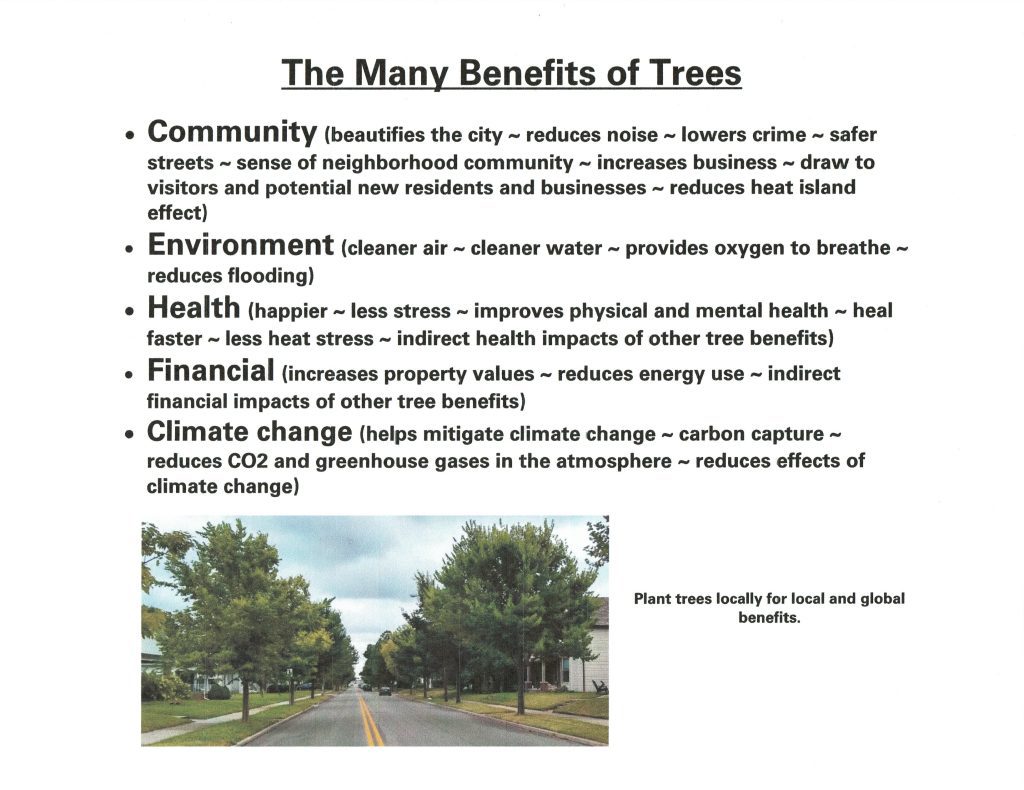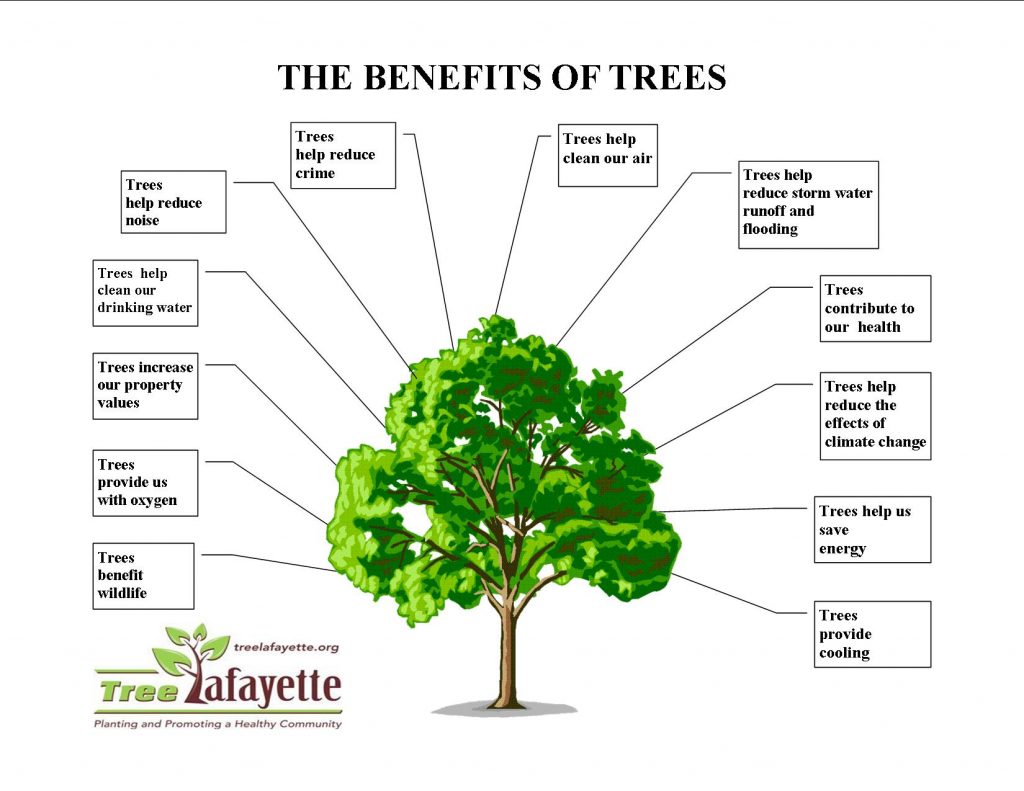Everyone needs to have access to the benefits of trees. It should not matter what race or income level.


The benefits of trees:
- Trees provide us with the oxygen to breathe. Trees are one of the largest generators of oxygen. Trees produce oxygen as they remove and use carbon dioxide from the air through the process of photosynthesis. Trees use the carbon dioxide that we exhale and that vehicles produce as emissions to produce oxygen.
- Trees clean the air by absorbing carbon dioxide, sulfur dioxide, nitrous oxides and other pollutants, and also shade cars and parking lots, reducing ozone emissions from vehicles. Trees can remove particulate from the air by giving the particulate a place to adhere on the leaves. Trees can also act as a filter as the particulate is blown through the trees. Cleaner air improves the health of people. Impact of Roadside Tree Lines on Indoor Concentrations of Traffic-Derived Particulate Matter.
- Trees reduce temperatures and can reduce energy usage/costs. Trees and vegetation lower surface and air temperatures by providing shade and through evapotranspiration. Shaded surfaces may be 20–45°F cooler than the peak temperatures of unshaded areas. Evapotranspiration, can help reduce peak summer temperatures by 2–9°F. Lower summertime temperatures can reduce the annoyance of high temperatures and reduce the likelihood of heat illnesses. The indirect cooling effect of evapotranspiration is greater than the direct effect of shading. As the number of trees in an area increase, the relative contribution of evapotranspiration to overall cooling goes up, mitigating the urban heat effect. Climate change may increase temperatures, so trees can help offset the heat increases. Cooler temperatures reduce the heat stress on individuals during the summer.
- Trees can help reduce crime. Public housing residents with nearby trees and natural landscapes reported 25% fewer acts of domestic aggression and violence. There is less graffiti, vandalism, and littering in outdoor spaces with natural landscapes than in comparable plant-less spaces. Apartment buildings with high levels of greenery had 52% fewer crimes than those without any trees. Buildings with medium amounts of greenery had 42% fewer crimes. Greater tree canopy cover is associated with lower rates of both violent and property crime in New Haven, CT.
- Trees benefit wildlife. Forests, including urban forests, help create and enhance animal and plant habitats and can act as “reservoirs” for endangered species. Urban forest wildlife offers enjoyment to city dwellers and can serve as indicators of local environmental health. Urban rewilding is bringing wildlife to the heart of cities.
- Trees can contribute to better health. Trees filter airborne pollutants and reduce the conditions that cause asthma and other respiratory problems. Researchers from Columbia University found childhood asthma rates were highest in parts of the city where tree density was lowest. The rate of asthma fell by 25% for every extra 340 trees per square kilometer, a pattern that held true even after taking account of differing sources of pollution, levels of affluence and population density. In a study, residents of areas with the highest levels of greenery were three times as likely to be physically active and 40% less likely to be overweight or obese than residents living in the least green settings. Neighborhood parks and treed trails promote exercise. Green environment impacts worker productivity: in one study workers without nature views from their desks claimed 23% more sick days than workers with views of nature. Park users report lower levels of anxiety and sadness after visiting parks. The longer park users stay in park settings, the less stress they report. Contact with nature not only decreases elementary school children’s stress, but higher amounts of exposure to natural environments indicate lower levels of stress in a child. Mental wellbeing improves from exercising outdoors compared to exercising indoors. Exercising in natural environments is associated with greater feelings of revitalization and positive engagement, decreases in tension, confusion, anger, depression, and increased energy. Living in Greener Areas Is Associated With Better Mental Health and Less Medication Use. The life-saving benefits of street trees. How planting trees can help address inequality and improve health. The association between tree planting and mortality: A natural experiment and cost-benefit analysis.
- Trees reduce storm water runoff and flooding. Trees draw large amounts of water from the ground. Trees slow the flow of water across the ground and allow the storm water to infiltrate into the ground. Tree roots prevent erosion of soil and reduce the amount of soil that is washed into ditches, streams, and rivers. Reducing storm water runoff reduces combined sewer overflow volumes.
- Trees help reduce noise levels by blocking and absorbing sounds.
- Tree lined streets and roads are safer for traffic. Speeds travelled may be reduced slightly and driver stress levels may be lower. Safe Streets.
- Trees help clean drinking water. The tree roots pull in contaminants as the water infiltrates down into the sublevels of the soil. Trees slow the storm water flow so that it can go into the soil, where bacteria and other microorganisms filter out impurities. This reduces urban runoff and the amount of sediment, pollutants, and organic matter that reach streams.
- Trees increase property values. The home or property value increases as trees are planted as potential buyers will pay more for the perceived value.
- Trees are good for business and the local economies. Shoppers are drawn to areas where there are trees planted. People have more favorable perceptions of communities with green roads and spaces. Prospective residents prefer green areas and trees. Urban Forestry Economic Analysis of Indiana.
- There are signs that climate change is occurring, whether by manmade issues or by nature doing its thing. We can offset some of the effects of climate change with more trees. Trees remove greenhouse gases from the atmosphere. Trees store carbon. Estimating carbon storage in urban forests of New York City.
- Trees encourage physical activity and spending time outdoors.
- Trees are inviting to neighbors to go outside and connect with one another.
- Trees reduce the instances of vandalism, graffiti, and littering. Greater tree canopy cover is associated with lower rates of both violent and property crime in New Haven, CT.
News:
- Detroit launches tree partnership, pledges to plant 75K trees over five years.
- Let’s Commit to Tree Equity in American Cities.
Additional Resources:
- The Case For Trees Report from the Arbor Day Foundation
- Trees and Plants: Benefits to the Community from Sea Grant North Carolina
- Vibrant cities cultivate thriving urban forests that boost public health, safety, sustainability and economic growth from Vibrant Cities Lab
- Green Cities: Good Health from University of Washington
